Abstract
1. CP 50,556, CP 55,940, nabilone, CP 56,667, delta 9 -tetrahydrocannabinol (THC) and cannabinol each inhibited electrically-evoked contractions of the myenteric plexus-longitudinal muscle preparation of guinea-pig small intestine in a concentration-related manner. The IC50 values of these cannabinoids, respectively 3.45, 3.46, 30.61, 162.94, 214.63, and 3913.5 nM, correlate well with previously obtained potency values for displacement of [3H]-CP 55,940 from cannabinoid binding sites. 2. Electrically-evoked contractions of the myenteric plexus-longitudinal muscle preparation were also inhibited by AM 630 (6-iodo-pravadoline) and by WIN 55,212-2 (IC50 = 1923.0 and 5.54 nM, respectively). The present finding that AM 630 is an agonist, contrasts with a previous observation that it behaves as a cannabinoid receptor antagonist in the mouse isolated vas deferens. 3. SR141716A produced dose-related parallel rightward shifts in the log concentration-response curves of CP 55,940, WIN 55,212-2, THC and AM 630 for inhibition of electrically-evoked contractions of the myenteric plexus-longitudinal muscle preparation. SR141716A (1 microM) did not reverse the inhibitory effects of normorphine and clonidine on electrically-evoked contractions or potentiate the contractile response to acetylcholine. 4. Doses of naloxone and yohimbine that reversed the inhibitory effects of normorphine or clonidine on electrically-evoked contractions of the myenteric plexus-longitudinal muscle preparation did not affect the inhibitory response to WIN 55,212-2. 5. Electrically-evoked release of acetylcholine from strips of myenteric plexus-longitudinal muscle was decreased by 200 nM CP 55,940 and this inhibitory effect was almost completely reversed by 1 microM SR141716A. Acetylcholine-induced contractions were not affected by 200 nM CP 55,940. 6. These results support the hypothesis that guinea-pig small intestine contains prejunctional cannabinoid CB1 receptors through which cannabinoids act to inhibit electrically-evoked contractions by reducing release of the contractile transmitter, acetylcholine. 7. THC was found to be more susceptible to antagonism by SR141716A than CP 55,940 or AM 630, raising the possibility that guinea-pig small intestine contains more than one type of cannabinoid receptor. 8. At concentrations of 10 nM and above, SR141716A produced small but significant increases in the amplitude of electrically-evoked contractions of the myenteric plexus-longitudinal muscle preparation suggesting that this tissue may release an endogenous cannabinoid receptor agonist or that some cannabinoid receptors in this tissue are precoupled and that SR141716A can reduce the number of receptors in this state.
Full text
PDF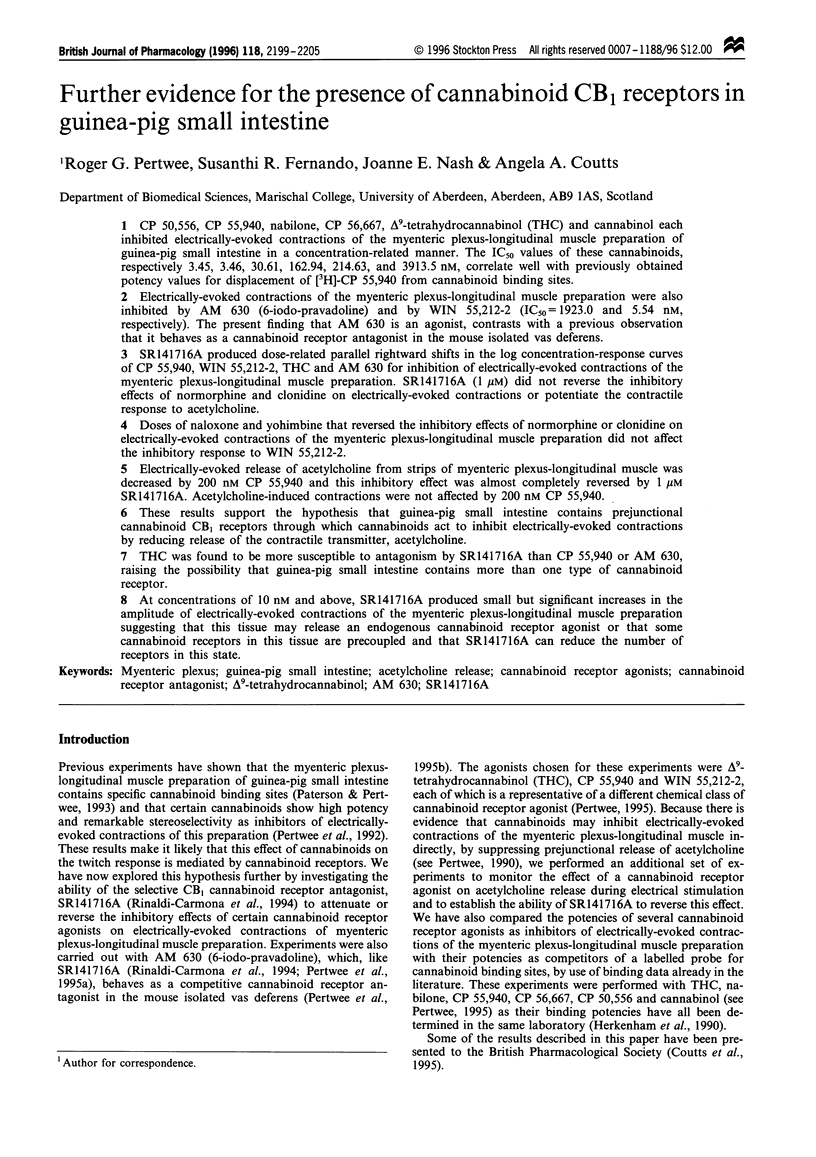
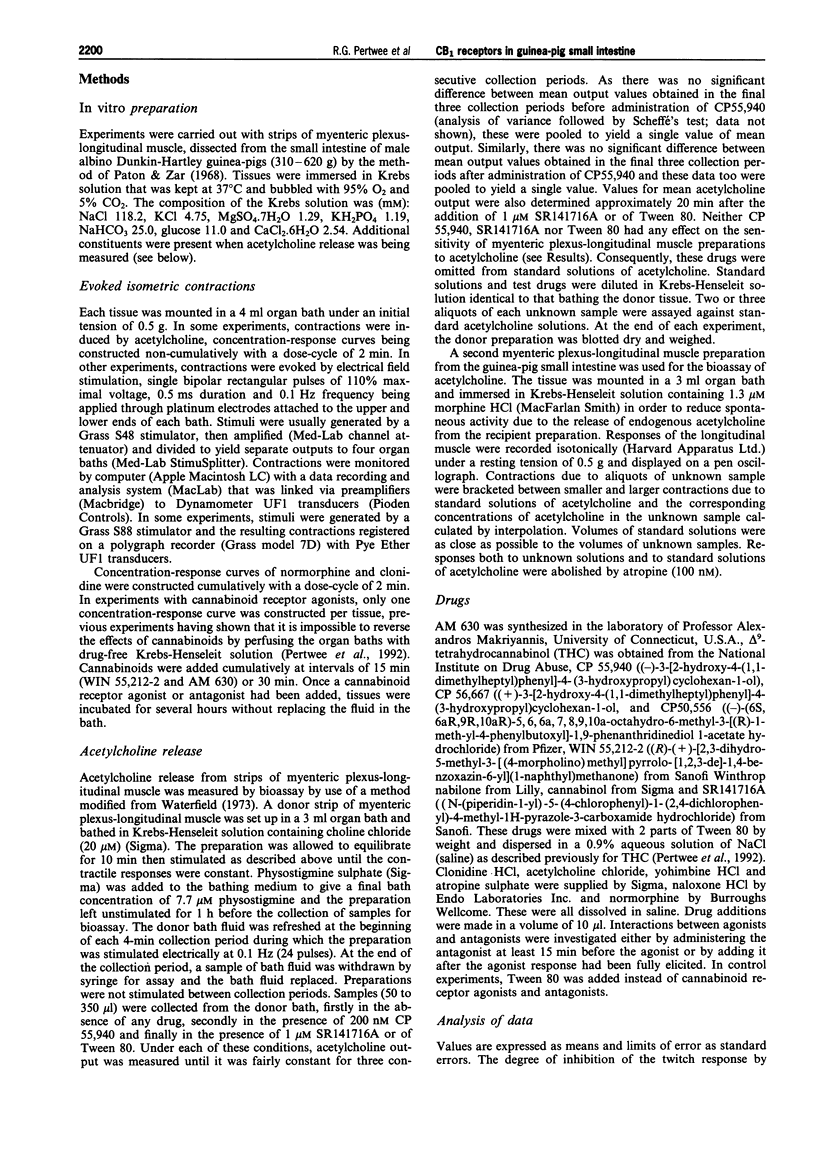
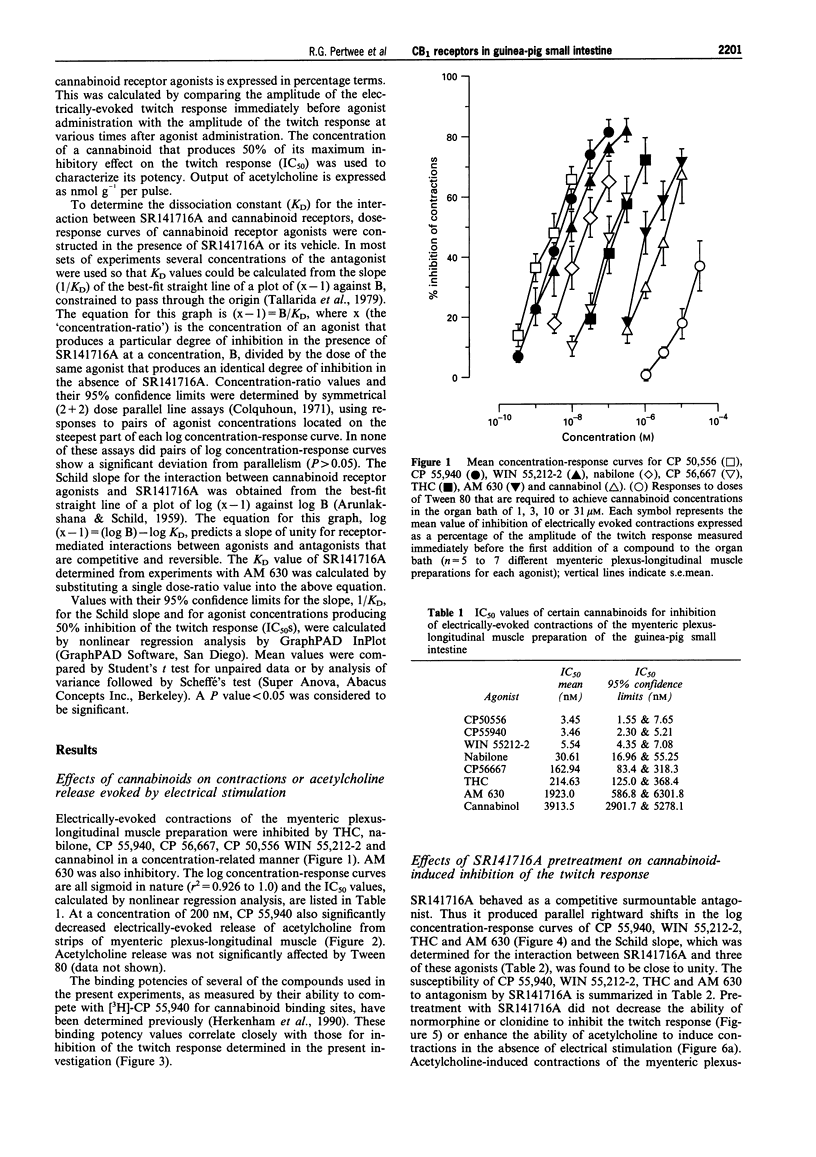
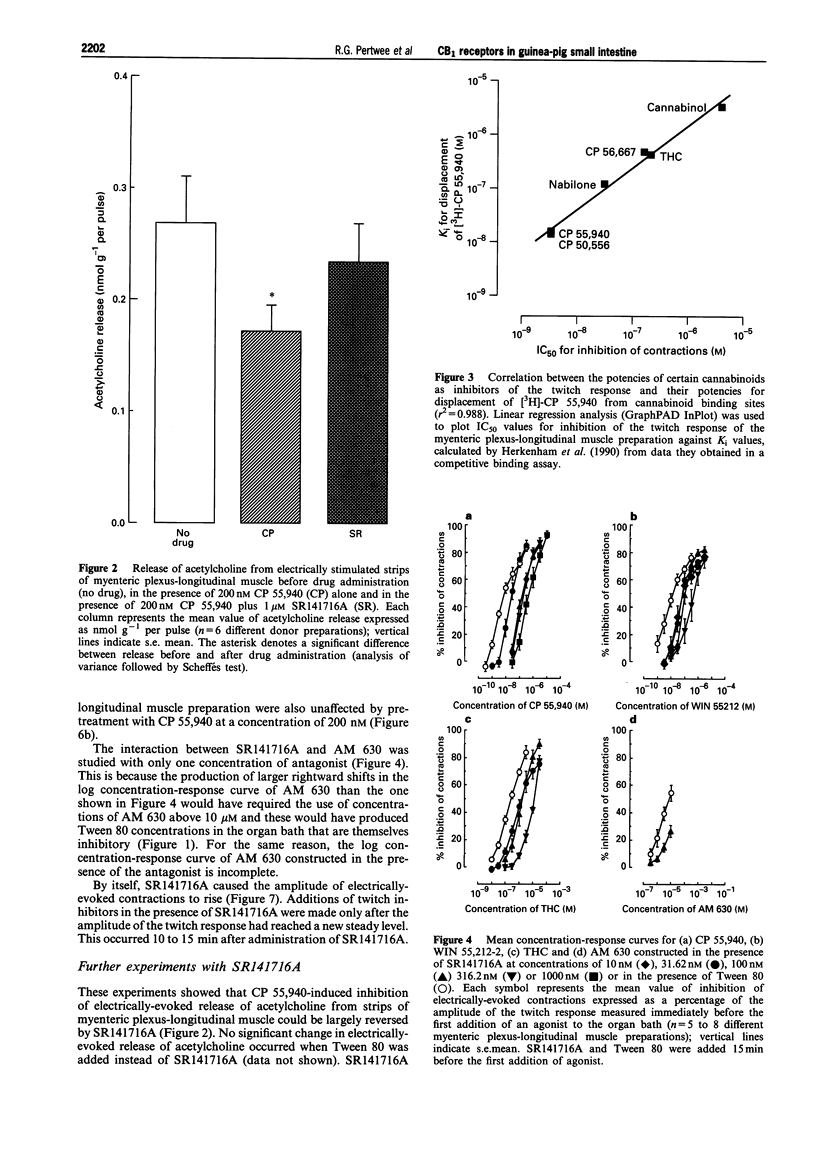
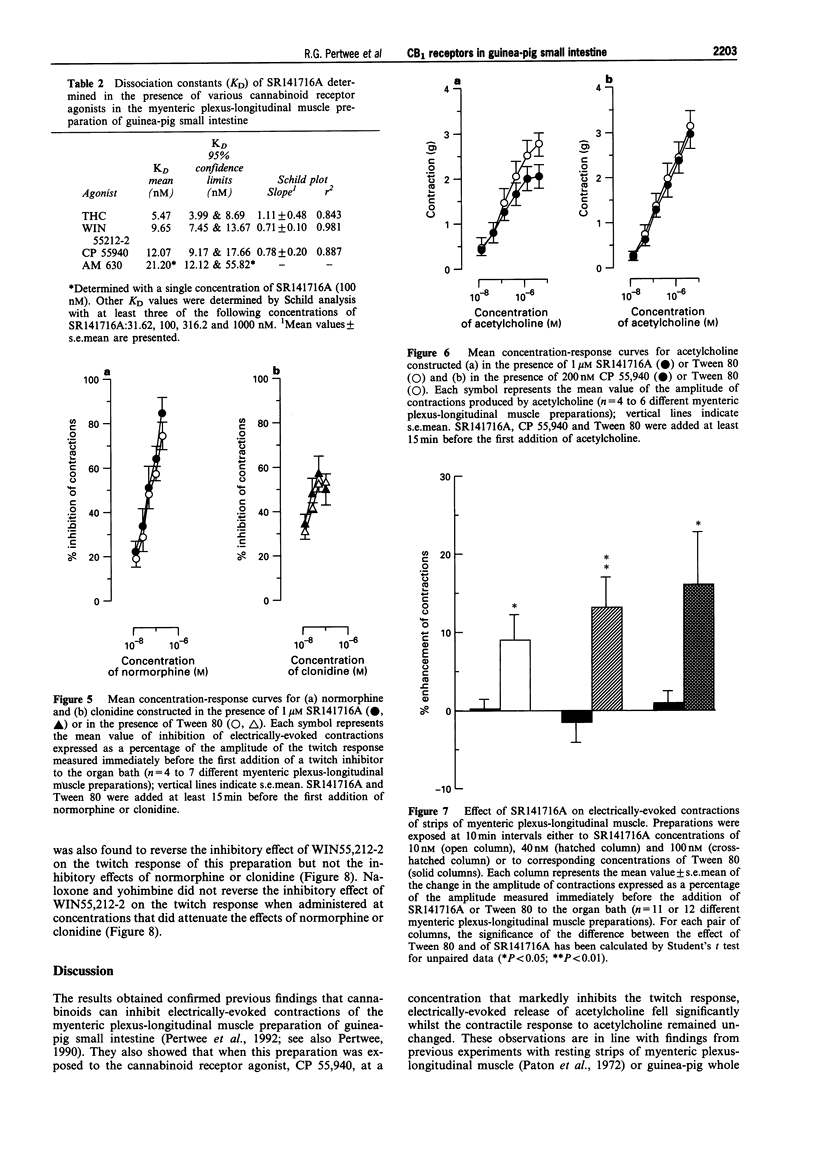
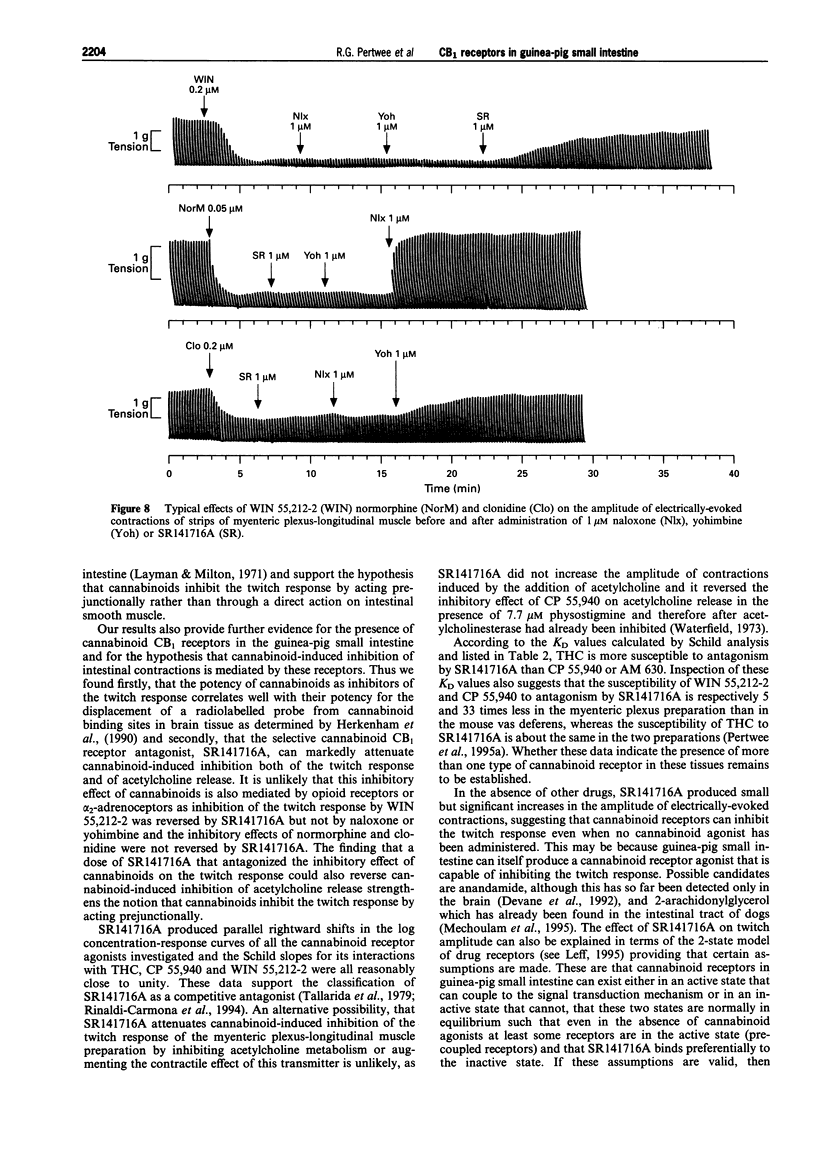
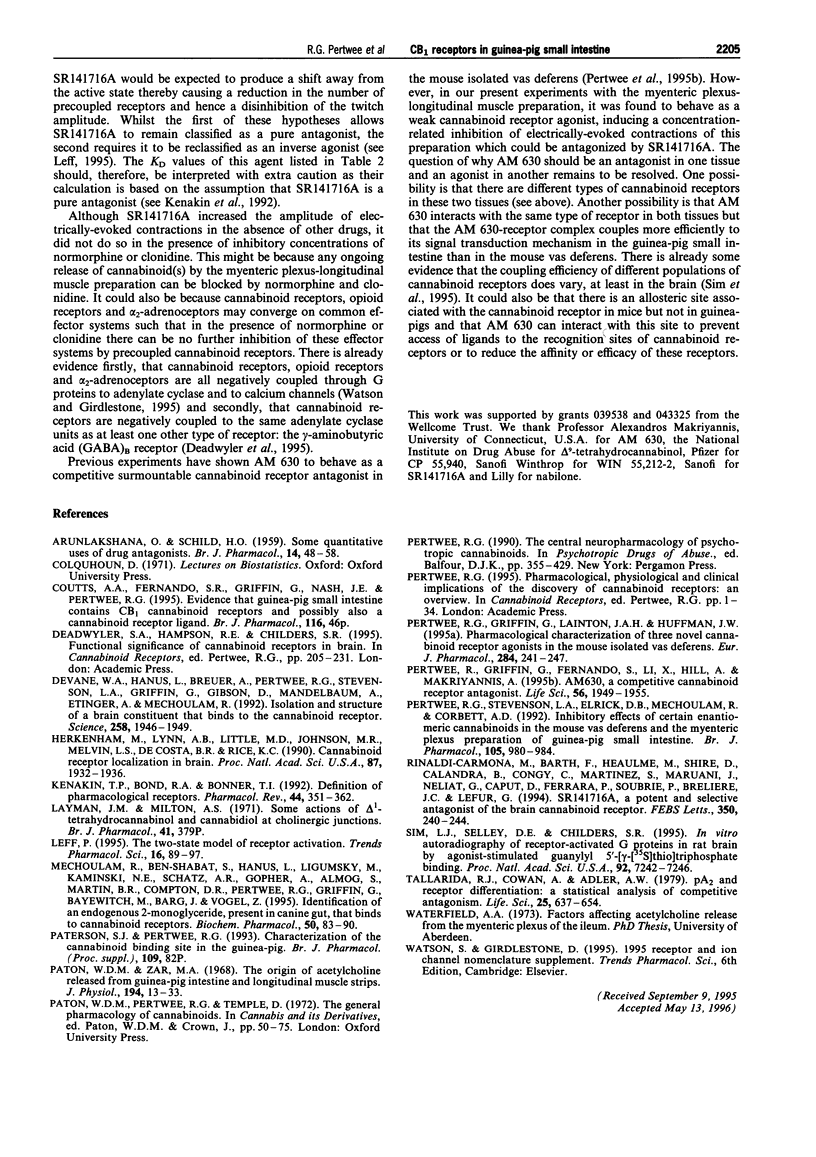
Selected References
These references are in PubMed. This may not be the complete list of references from this article.
- ARUNLAKSHANA O., SCHILD H. O. Some quantitative uses of drug antagonists. Br J Pharmacol Chemother. 1959 Mar;14(1):48–58. doi: 10.1111/j.1476-5381.1959.tb00928.x. [DOI] [PMC free article] [PubMed] [Google Scholar]
- Devane W. A., Hanus L., Breuer A., Pertwee R. G., Stevenson L. A., Griffin G., Gibson D., Mandelbaum A., Etinger A., Mechoulam R. Isolation and structure of a brain constituent that binds to the cannabinoid receptor. Science. 1992 Dec 18;258(5090):1946–1949. doi: 10.1126/science.1470919. [DOI] [PubMed] [Google Scholar]
- Herkenham M., Lynn A. B., Little M. D., Johnson M. R., Melvin L. S., de Costa B. R., Rice K. C. Cannabinoid receptor localization in brain. Proc Natl Acad Sci U S A. 1990 Mar;87(5):1932–1936. doi: 10.1073/pnas.87.5.1932. [DOI] [PMC free article] [PubMed] [Google Scholar]
- Kenakin T. P., Bond R. A., Bonner T. I. Definition of pharmacological receptors. Pharmacol Rev. 1992 Sep;44(3):351–362. [PubMed] [Google Scholar]
- Layman J. M., Milton A. S. Some actions of delta-1 tetrahydrocannabinol and cannabidiol at cholinergic junctions. Br J Pharmacol. 1971 Feb;41(2):379P–380P. doi: 10.1111/j.1476-5381.1971.tb08039.x. [DOI] [PMC free article] [PubMed] [Google Scholar]
- Leff P. The two-state model of receptor activation. Trends Pharmacol Sci. 1995 Mar;16(3):89–97. doi: 10.1016/s0165-6147(00)88989-0. [DOI] [PubMed] [Google Scholar]
- Mechoulam R., Ben-Shabat S., Hanus L., Ligumsky M., Kaminski N. E., Schatz A. R., Gopher A., Almog S., Martin B. R., Compton D. R. Identification of an endogenous 2-monoglyceride, present in canine gut, that binds to cannabinoid receptors. Biochem Pharmacol. 1995 Jun 29;50(1):83–90. doi: 10.1016/0006-2952(95)00109-d. [DOI] [PubMed] [Google Scholar]
- Paton W. D., Zar M. A. The origin of acetylcholine released from guinea-pig intestine and longitudinal muscle strips. J Physiol. 1968 Jan;194(1):13–33. doi: 10.1113/jphysiol.1968.sp008392. [DOI] [PMC free article] [PubMed] [Google Scholar]
- Pertwee R. G., Griffin G., Lainton J. A., Huffman J. W. Pharmacological characterization of three novel cannabinoid receptor agonists in the mouse isolated vas deferens. Eur J Pharmacol. 1995 Sep 25;284(3):241–247. doi: 10.1016/0014-2999(95)00318-f. [DOI] [PubMed] [Google Scholar]
- Pertwee R. G., Stevenson L. A., Elrick D. B., Mechoulam R., Corbett A. D. Inhibitory effects of certain enantiomeric cannabinoids in the mouse vas deferens and the myenteric plexus preparation of guinea-pig small intestine. Br J Pharmacol. 1992 Apr;105(4):980–984. doi: 10.1111/j.1476-5381.1992.tb09088.x. [DOI] [PMC free article] [PubMed] [Google Scholar]
- Pertwee R., Griffin G., Fernando S., Li X., Hill A., Makriyannis A. AM630, a competitive cannabinoid receptor antagonist. Life Sci. 1995;56(23-24):1949–1955. doi: 10.1016/0024-3205(95)00175-6. [DOI] [PubMed] [Google Scholar]
- Rinaldi-Carmona M., Barth F., Héaulme M., Shire D., Calandra B., Congy C., Martinez S., Maruani J., Néliat G., Caput D. SR141716A, a potent and selective antagonist of the brain cannabinoid receptor. FEBS Lett. 1994 Aug 22;350(2-3):240–244. doi: 10.1016/0014-5793(94)00773-x. [DOI] [PubMed] [Google Scholar]
- Sim L. J., Selley D. E., Childers S. R. In vitro autoradiography of receptor-activated G proteins in rat brain by agonist-stimulated guanylyl 5'-[gamma-[35S]thio]-triphosphate binding. Proc Natl Acad Sci U S A. 1995 Aug 1;92(16):7242–7246. doi: 10.1073/pnas.92.16.7242. [DOI] [PMC free article] [PubMed] [Google Scholar]
- Tallarida R. J., Cowan A., Adler M. W. pA2 and receptor differentiation: a statistical analysis of competitive antagonism. Life Sci. 1979 Aug 20;25(8):637–654. doi: 10.1016/0024-3205(79)90505-8. [DOI] [PubMed] [Google Scholar]


